Hi maroun.c
I had a couple of impressions looking over what you've done. Overall, you did a fine job and you'll learn a lot from this experiment. I wouldn't do anything at this point - just leave it be and let it grow. Please take the following as constructive feedback for the next time you try this:
- I don't know your climate, but this seems like an odd time of year to be doing this kind of work. I know some folks who do autumn repotting, but generally I avoid it if I have the choice in preference to early spring. I didn't see any before pictures, but elms are pretty tough - it will probably be fine but may suffer some leaf drop.
- Your tree seems to have inverse taper right at the base. This will be difficult to correct. You might eventually consider ground layering to remove the inverse taper and starting over again.
- Make sure that you remove all of the old sphagnum peat from around the roots. I wash them off with a hose.
- Consider using a wider grow box so you can let the roots run horizontally for a long distance. You can build it out of pine wood or use a shallow plastic tray. The idea is that as you let the surface roots run they get strong. As the surface roots get strong, they provide more of the water and nutrients the tree needs and receive most of the sugars. This stimulates cell division at the root/stem junction - that combined with the fusion of the strong surface roots is what causes the basal flare.
- The purpose of the nails is to direct the roots radially from the trunk. If you put the nails closer to the trunk you have more control of the direction the roots leave the trunk. Like in the picture below.
- It doesn't appear as though you wired the tree to the pot. Always do this. Just run some aluminum wire through the drainage holes and drainage layer and twist the ends over the top of the board to hold it in place tightly. You don't want any movement at all so the new roots can get established.
- Another thing to consider is the root pruning. The goal is to make the root ball balanced. This means that you want an even distribution of roots around the trunk and you want them to all be the same strength. So every time you repot, it's an opportunity to rebalance the roots - this means cutting back the strong ones and leaving the weak ones long. Look at your example - the long ones have all been left long. That means they'll continue to be the strongest roots next growing season and you'll be more out-of-balance the next time you repot.
View attachment 116424
Hi Scott and thanks for all the suggetions. a few replies
1. summer is just ending here and temp has just started dropping (around 25-30 degrees Celsius) agree its a bad time for this but had this elm left from few I got for an elm forest and it was in a nylon small pot and roots were pot bound so had no other choice than go with this now...
2. good catch. it does have a bit of reverse taper but I was hoping the thicker base would exten a bit and either correct it or maybe hide it a bit? would definitely want to avoid an air layer and restart as I want to train on Ebihara. do you suggest a restart with another tree ?
3. all sphagnum was removed by washing.
4. I have a couple of larger pots with larger wood ready to redo this one or maybe a couple new ones.
5.Spot on. I struggled with this root as it was a bit too stiff to move and was afraid to break it especially after I had taken out more than 80% of the roots. will try to fix at earliest chance.
Scott
6-Correct I didn't wire will redo on first chance.
7-Correct but I did a very bad job cleaning the roots and lost most while cleaning... so thought to keep what's possible at least till next repot and take all thick roots for a more balanced rootball next time. do you think I can take those off or will it be too few roots to sustain the tree?
Thanks.

















